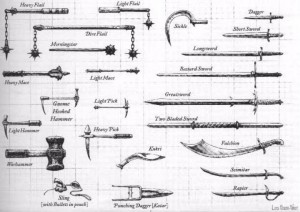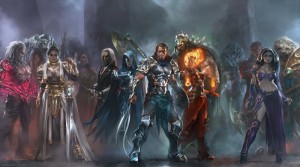While the Dungeon’s Master team enjoys some well-deserved vacation time, we’re breaking out the greatest hits and shining a spotlight on a few of our favourite articles from 2013. We’ve searched for hidden gems that our newer readers might have missed and our long-time readers will enjoy reading again. Enjoy a second look at these greatest hits from Dungeon’s Master.
It was a welcome treat to have Wimwick contribute a few articles in April when we were doing the A to Z Blogging Challenge. This article for the letter “W” really came at the right time. As more and more people participated in the D&D Next play testing we saw a lot of new characters during public play. If we were lucky, players took 2 or 3 of the Ws into account when making characters. But it was rare that they ever took all 6 into account.
Regardless of what edition you’re playing or even what RPG you’re playing, this article provides players with great points for developing a really interesting a well rounded character. By defining your PC as more than a race & class you’re bound to have even more fun playing him.
Wimwick’s suggestion to add the extra W for weapon was an especially good point. A Lot of players pick the weapon that does the most damage and don’t take “coolness” into account. They forget that the kind of weapon you wield says as much about your character as the other 5 Ws.
After you answer the 6 Ws, be sure to incorporate those details into the game as you play. These are the things that make your character unique so be sure to share those details. Make the character memorable for the entire table and not just for you. Encourage other players to put the same kind of thought into their own PCs, and if they need help getting started you can point them back to this article.
From April 26, 2013, Dungeon’s Master once again presents: 6 Ws of Character Creation.
Character creation is perhaps my favourite aspect of Dungeons & Dragons. However, it’s not selecting the class, feats or powers that I enjoy. Sure, looking for synergies and developing a concept around the play style I’m interested in is fun. However, I spend just as much time working on the character’s background. I’m interested in the character’s story as this assists me in role-playing the character effectively. Whenever I’m creating a character I always ask the six W’s: Who, What, When, Why, Where and Weapon. The six Ws combine to fill in and flesh out the details of a character’s history.
Although the six Ws inter-relate we will review and consider each one individually.
Who
It seems like a simple question to ask who is your character? In many ways who your character is captures many of the other other Ws. So what are the questions you should ask when looking to define who your character is?
- Who are your parents and siblings?
- Who are your mentors and idols?
- Who gave you your first weapon or taught you your first spell?
- Who in your life would you protect from harm and give up anything to save?
What
The question of what your character is can be defined by the choices you make in character creation. Your race, class, power and feat selections. All of these elements define what you can do. When someone asks about your character, they ask “What are you playing?” The response is usually, “A Mindshard Runepriest!” Ok, maybe that isn’t the usual response, but you get the idea. So what questions do you need to ask in order to get beyond the race and class of your character?
- What motivated you to become an adventurer?
- What from your past do you fear?
- What do you look forward to in the future?
- What event in the future do you fear might become reality?
- What is your social status?
When
Asking questions surrounding when are perhaps more difficult. What these questions tend to do is give a time reference to many of the other questions about your character’s history and ongoing saga. However, there are a few questions you can ask in order to help fill out some of your motivations. You will notice with questions that ask when, invariably one of the other Ws shows up in the question. Questions about when help you flesh out motivations and character traits. They let you ask if you are out for revenge, justice or both in dealing with past injustices.
- When you accomplish your current mission/adventure what will you do?
- When you retire from adventuring what will you do?
- When you avenge a wrong from your past, what will you do? How will you feel?
- When you meet a NPC who wronged you, how will you treat them?
Why
You can ask ‘what motivated you to become an adventurer’ or you can substitute the what with a why. Why again provides overlap into the areas that other Ws cover. Questions surrounding why, deal with character motivation. These questions help you distinguish your character from other similar characters.
- Why did you decide to become a Fighter (defender)? Why not a Slayer (striker)?
- Why do you travel with your current adventuring party?
- Why do you rebel/submit to authority?
- Why do you continue to adventure?
Where
Some of the questions in this category deal with character background. Others allow you to vision for the future, allowing you to create a career path.
- Where are you from?
- Where do you want to be in 5/10 years (or replace years with levels)?
- Where does your motivation to adventure come from?
 Weapon
Weapon
In D&D your weapon is just how you use your power. It really isn’t the weapon that is doing anything special, it is the power you selected during character creation. Or is it? Drizzt is cool because he dual wields scimitars. Legolas is awesome because of his proficiency with the bow. Druss is Captain of the Axe, because he wields and axe. Do you attack by using power xand then roll the dice? Or do you face off against your opponent, bellowing a furious war cry as you smash your axe into their ribs?
It is all fine and well to select a weapon because of its damage dice and other property. However, after you do that own the weapon. Make every swing, thrust and parry matter.
How do you go about creating your character’s background? What questions do you ask and where do you search for inspiriation?
Related reading:
- What Your Weapon Says About Your Character
- Character Motivation
- Your Characters Psychological Profile
 Looking for instant updates? Subscribe to the Dungeon’s Master feed!
Looking for instant updates? Subscribe to the Dungeon’s Master feed!

3 replies on “Greatest Hits 2013: 6 Ws of Character Creation”
One of the things I often do with the WHERE question is to have the player create their home town (or neighborhood of a big city) for me. That’ll give me NPCs and a reference point. It also makes the players feel like the world is partially theirs. We’re in a collaborative story-telling experience, and we’re building this world together.
The other “W” I sometimes use is Will… as in Will you do X or Y in a given situation. While we don’t often do full-on Myers-Briggs personality tests with our characters, it can be instructive to a DM to know that in a hypothetical situation where a villain leaves his bag of gold unguarded to beat a peasant, will that player help the peasant, or go for the gold first? Of course, I always follow that up with a “Why”. Not to judge one action as better than the other, but to understand what is really motivating the character (and to help the player figure that out as well).
Sometimes, the most defining aspect of a character is their weapon of choice. Last year, I made a character for an Eberron campaign. It was a warforged paladin, which was notable in itself, but what had the other players talking about my character for months was his primary weapon: his fist would sprout blades, detach from the wrist, and hang on a chain. All I did was take a flail and file off the serial numbers, but it added a lot of character to the character (so to speak).
As for standard spells, they come in the usual schools of magicka: destruction (zap skeletons with sparks!), conjuration (summon a giant frost atronach!), alteration (light the way ahead!), and so on. You can even dual-wield spells, going full-on mage, with a glowing ball of fire in one hand and a summon at the ready in the other. For that matter, you can dual-wield one-handed weapons, giving you more flexibility in how you form your character. When you create your character, you choose a race from the usual Elder Scrolls standbys (Dark Elf, Breton, Argonian, and so forth), but you don’t choose a class. Rather, your skill level with certain types of weapons, magicka schools, speech, and so on is governed primarily by how you play. Wear heavy armor, and taking blows gradually increases your heavy armor proficiency. Swing two-handed weapons, and you get better at using them.